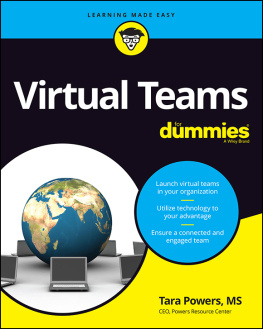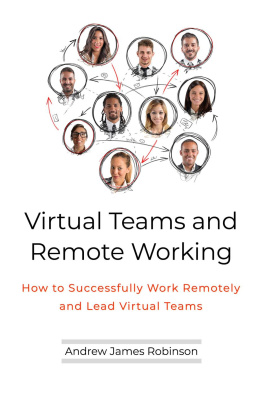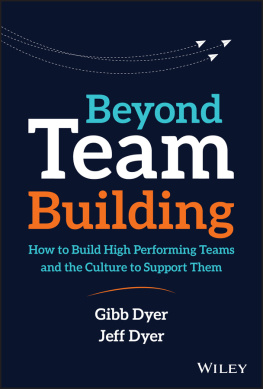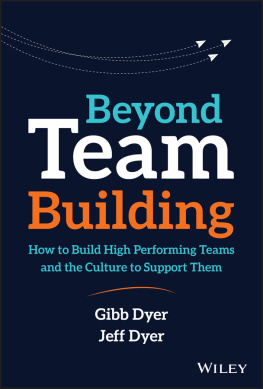Working at a Distance
Working at a Distance
A Global Business Model for Virtual Team Collaboration
CASSANDRA J. SMITH

First published 2014 by Gower Publishing
Published 2016 by Routledge
2 Park Square, Milton Park, Abingdon, Oxon OX14 4RN
711 Third Avenue, New York, NY 10017, USA
Routledge is an imprint of the Taylor & Francis Group, an informa business
Copyright Cassandra J. Smith 2014
Cassandra J. Smith has asserted her moral right under the Copyright, Designs and Patents Act, 1988, to be identified as the author of this work.
Gower Applied Business Research
Our programme provides leaders, practitioners, scholars and researchers with thought provoking, cutting edge books that combine conceptual insights, interdisciplinary rigour and practical relevance in key areas of business and management.
All rights reserved. No part of this book may be reprinted or reproduced or utilised in any form or by any electronic, mechanical, or other means, now knownor hereafter invented, including photocopying and recording, or in any information storage or retrieval system, without permission in writing from the publishers.
Notice:
Product or corporate names may be trademarks or registered trademarks, and are used only for identification and explanation without intent to infringe.
British Library Cataloguing in Publication Data
A catalogue record for this book is available from the British Library.
Library of Congress Cataloging-in-Publication Data
Smith, Cassandra J.
Working at a distance : a global business model for virtual team collaboration / by Cassandra J. smith.
pages cm
Includes bibliographical references and index.
ISBN 978-1-4724-2523-2 (hardback : alk. paper)
1. Virtual reality in management. 2. Virtual work teamsManagement. I. Title.
HD30.2122.S65 2014
658.4022dc23
2013042240
ISBN: 9781472425232 (hbk)
ISBN: 9781315546391 (ebk)
CONTENTS
LIST OF FIGURES AND TABLES
FIGURES
TABLES
ABOUT THE AUTHOR
Cassandra Smith is an online instructor. She has been writing for over twenty years, and teaching in the online environment for six years. She has taught several courses online and facilitated a number of virtual teams. She has also designed Web-based courses and trained online faculty. She is the author of the course guide for online facilitators Who Let this Disaster in My Classroom? A Practical Guide for Online Instructors and Some Funny Stories Along the Way (2009) and Ethical Behaviour in the E-Classroom: What the Online Student Needs to Know (2012), a textbook for online students featuring ethical theories as they relate to working in the online environment along with critical thinking concepts. She holds a Bachelor of Science degree in Communication from the University of Mobile and a Master of Arts in Education with an emphasis on Adult Education and Distance Learning from the University of Phoenix. She is currently a doctoral candidate in the Postsecondary and Adult Education discipline.
ACKNOWLEDGMENTS
The idea of writing a book about virtual teams came about as a result of working in and facilitating them. My experiences with students and as a student led to my research on how to manage virtual teams more effectively. It is my hope that this book will serve as a guide to virtual team development for business professionals and those working in higher education.
I would like to thank God for all my ideas and purpose in life. I want to thank my husband for his continuous support and consistent spiritual guidance and love. I want to thank my mother, father, siblings, nephews, and family. Their support and love have been the catalyst for me to meet my goals. I love you.
To Gower PublishingI want to express my sincere gratitude for accepting this book. You are a true leader in the business and education industry.
To my studentsyou helped me grow. I pray that I have been an excellent instructor and example of the importance of lifelong learning.
REVIEWS OF WORKING AT A DISTANCE
Many projects fail in the virtual environment because project managers rely on the assumptions and communication strategies they use in the face-to-face environment. Smiths Virtual Team Global Business Model makes a significant contribution to working and learning at a distance because she provides a concrete model that helps managers examine their assumptions and tailor their communication practices to work effectively at a distance.
Howard R. Jacobs, School of Education, Capella University, USA
Cassandra Smiths Virtual Team Global Business Model is a methodology that can finally make virtual teamwork viable. Through her thoughtful and creative structuring of goal-planning, role-definition, communication, and much more, Smith paints a multifaceted picture of how this business process can work in higher education. We no longer should hear, oh, no, not another team assignment!
Tamara Fudge, Kaplan University, USA
CHAPTER 1
INTRODUCING THE VIRTUAL TEAM GLOBAL BUSINESS MODEL
As a manager, you have established your goals and objectives for your employees working at a distancein virtual teamswith their coworkers. You are certain that your expectations are clear. You have submitted the expectations to your employees in the form of statements with the end goal in mindyour mind. Your deliverable due dates are set in place as well, and you expect your employees to submit project deliverables by due dates. You believe that your employees working collaboratively understand the Web-based technology required to submit the deliverables. You believe that your employees understand how to communicate in their teams. You reason that your employees know how to use email and any real-time platforms that your company uses to communicate. All systems are set in place and ready for completion of the project.
But consider this scenarioa distance projectfrom the perspectives of your employees working at a distance: there is a project due, and your employer has assigned you to work with others to complete the project. This sounds like a simple feat. The issue is that you are not in the same location as your counterparts, your team members, your peers. You are working at a distance, assigned to a virtual team. You might be wondering where to begin. You have no guidelines or set rules. The goals and objectives are ambiguous to you and read like a list of commands, not clear steps on how to proceed. You might have initiated contact with some of your team members by email, only to find that only a few members have responded. One member has informed you that he prefers to use Skype, so please Skype him. You wonder to yourself, Is this indicative of how effective the team will progress? You have a myriad of questions. Since you initiated the email, are you now considered the team leader, the go-to person? Will there be a team leader? Where are management? Should you approach management about how to move forward? Will that make it look like youre not a competent employee who understands remote working?
This book was developed to help professionals and participants in higher education working at a distance in what are known as virtual teams. Virtual teams occur when groups that are geographically dispersed work together using Web technologies to complete projects. Virtual teams facilitate work that occurs across diverse and disseminated areas and business centers; some virtual teams are in offices throughout the country and globally for businesses; some virtual teams are in employees home offices. Universities also find virtual teams useful as they are part of curricula to foster collaborative learning among students.
Next page






